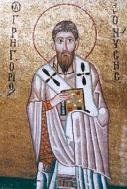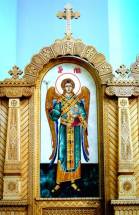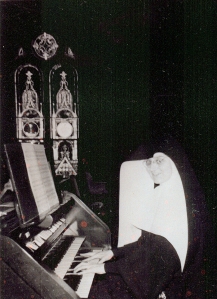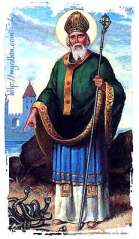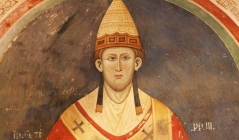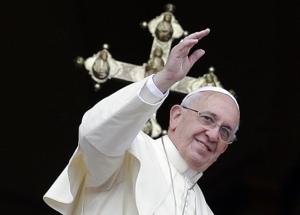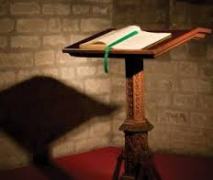 Purification and Enlightenment. That’s what the season of Lent is called within the Rite of Christian Initiation of Adults (RCIA), and that’s something we’re all called to be doing. As Holy Week approaches swiftly, and on a secular note, as our politicians continue their posturing in anticipation of future elections, I thought that the following quotes from some of our early bishops from the 4th Century would be a challenging source of reflection, purification and enlightenment. Just as in our own day, the 4th Century was a time of political, military, social and economic upheaval. Extreme wealth and extreme poverty existed side by side. In their homilies during the Eucharist, these bishops took their people to task in strong, unambiguous terms.
Purification and Enlightenment. That’s what the season of Lent is called within the Rite of Christian Initiation of Adults (RCIA), and that’s something we’re all called to be doing. As Holy Week approaches swiftly, and on a secular note, as our politicians continue their posturing in anticipation of future elections, I thought that the following quotes from some of our early bishops from the 4th Century would be a challenging source of reflection, purification and enlightenment. Just as in our own day, the 4th Century was a time of political, military, social and economic upheaval. Extreme wealth and extreme poverty existed side by side. In their homilies during the Eucharist, these bishops took their people to task in strong, unambiguous terms.
 Namely: the Eucharist and our understanding of charity and social justice go together. As Christ taught and lived, we cannot love God without loving our neighbor. It’s just that simple, and that challenging. Here are some insights from some of the great bishops of our history. Obviously there are many more, but these should get us all thinking! Imagine: you have just entered into the Eucharist with your fellow parishioners in Constantinople, or Nyssa, or Caesarea, or Milan. The deacon has finished proclaiming the Gospel, and your bishop enters the pulpit. Listen to your bishop!
Namely: the Eucharist and our understanding of charity and social justice go together. As Christ taught and lived, we cannot love God without loving our neighbor. It’s just that simple, and that challenging. Here are some insights from some of the great bishops of our history. Obviously there are many more, but these should get us all thinking! Imagine: you have just entered into the Eucharist with your fellow parishioners in Constantinople, or Nyssa, or Caesarea, or Milan. The deacon has finished proclaiming the Gospel, and your bishop enters the pulpit. Listen to your bishop!
 St. John Chrysostom, the great 4th Century Archbishop of Constantinople, preached frequently and eloquently (“Chrysostom” is a title of sorts, meaning “golden-mouthed” for his eloquence as a preacher) about the care of the needy. “Feeding the hungry is a greater work than raising the dead,” for example. He observed that “The Body of Christ in the Eucharist demands pure souls, not costly garments,” which naturally did not endear him to the wealthy members of the Byzantine court in Constantinople. John was not above using graphic images to shock his listeners. Consider how you would feel if your bishop including this line in his homily: “Do you pay such honor to your excrements as to receive them into a silver chamber-pot when another man made in the image of God is perishing in the cold?”
St. John Chrysostom, the great 4th Century Archbishop of Constantinople, preached frequently and eloquently (“Chrysostom” is a title of sorts, meaning “golden-mouthed” for his eloquence as a preacher) about the care of the needy. “Feeding the hungry is a greater work than raising the dead,” for example. He observed that “The Body of Christ in the Eucharist demands pure souls, not costly garments,” which naturally did not endear him to the wealthy members of the Byzantine court in Constantinople. John was not above using graphic images to shock his listeners. Consider how you would feel if your bishop including this line in his homily: “Do you pay such honor to your excrements as to receive them into a silver chamber-pot when another man made in the image of God is perishing in the cold?”
He didn’t mince words about our responsibilities to the poor:
“It is foolishness and a public madness to fill the cupboards with clothing and allow men who are created in God’s image and likeness to stand naked and trembling with cold, so that they can hardly hold themselves upright.”
“Yes, you say, he is cheating and he is only pretending to be weak and trembling. What! Do you not fear that lightning from Heaven will fall on you for this word? Indeed, forgive me, but I almost burst from anger.”
“Only see, you are large and fat, you hold drinking parties until late at night, and sleep in a warm, soft bed. And do you not think of how you must give an account of your misuse of the gifts of God? On the other hand, you question very closely the poor and the miserable, who are scarcely better off in this respect than the dead: and you do not fear the dreadful and the terrible judgment seat of Christ. If the beggar lies, he lies from necessity, because your hardheartedness and merciless inhumanity force him to such cheating. . . . If we would give our alms gladly and willingly, the poor would never have fallen to such depths.”
“Truly, I am ashamed when I see rich people riding about on horses decorated with gold and with servants clad in gold coming along behind them. They have silver beds and multitudes of other luxuries. But, if they have to give something to a poor man, suddenly they themselves are the poorest of the poor!”
If Archbishop John’s passion for the poor doesn’t convince you, consider some others.
Bishop St. Gregory of Nyssa and his brother Bishop St. Basil of Caesarea were no shrinking violets either.
Bishop Gregory: “We are all of the same family; all of us are brothers. And
among brothers it is best and most equal that all inherit equal portions.”
Bishop Basil: “The bread in your cupboard belongs to the hungry man; the coat hanging unused in your closet belongs to the man who needs it; the shoes rotting in your closet belong to the man who has no shoes; the money which you put in the bank belongs to the poor. You do wrong to everyone you could help, but fail to help.”
And how could we not include the great Bishop of Milan, Ambrose? The outline of his own life is well known, but when he became the bishop of Milan, he immediately adopted an ascetic lifestyle, giving everything he had to the poor. The only funds he retained he earmarked to care for his sister, who later became a nun herself. So, here we are in the cathedral, listing to our Bishop Ambrose giving this homily at Mass:
“Wealth, which so often leads men the wrong way, is seen less for its qualities than for the human misery it stands for. The large rooms of which you are so proud are in fact your shame. They are big enough to hold crowds and also big enough to shut out the voice of the poor. True, even if the voice were heard, it would be ignored. . . . The poor man cries before your house, and you pay no attention. There is your brother, naked, crying, and you stand confused over the choice of an attractive floor covering.”
As we continue our own journey of purification and enlightenment, these great bishops from our past can help us for the demands of Christian discipleship of today. The measure of our holiness lies in how well we care for the poor and all those in need.

